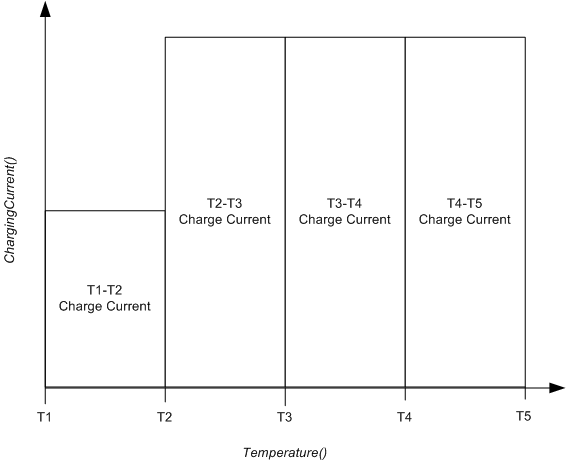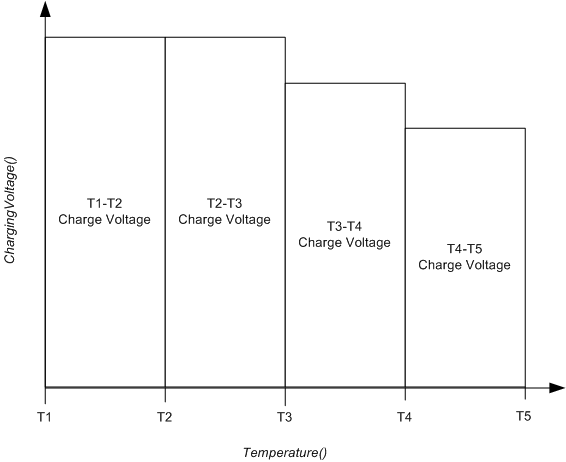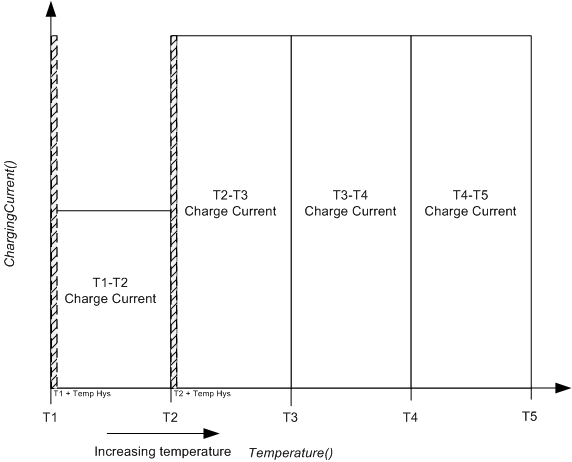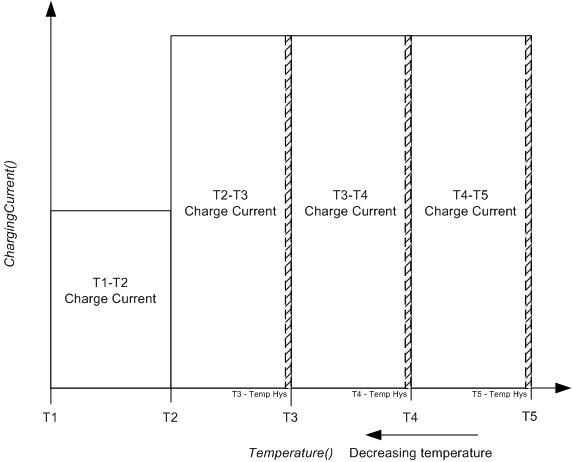SLUUB65B May 2015 – December 2022
- Read This First
- 1 Introduction
- 2 Basic Measurement System
- 3 Device Power Modes
- 4 Device Configuration Registers
- 5 System Control Function
-
6 Impedance Track Fuel Gauging
- 6.1 Introduction
- 6.2 Gauge FW Operation Modes
- 6.3 Current/Power Profiles
- 6.4 Qmax Update
- 6.5 Fast Qmax Update
- 6.6 Resistance Update
- 6.7 Fast Resistance Scaling
- 6.8 StateOfCharge() Smoothing
- 6.9 Additional Impedance Track Gauging Features
- 7 Charging Features
- 8 Lifetime Data Logging Features
- 9 Authentication
- 10Communications
- 11Manufacturer Information
- 12Manufacturer Data
- 13Integrity Data or Checksum
- 14Calibration
-
15Data Commands
- 15.1
Standard Data Commands
- 15.1.1
Control(): 0x00 and 0x01
- 15.1.1.1 CONTROL_STATUS: 0x0000
- 15.1.1.2 DEVICE_TYPE: 0x0001
- 15.1.1.3 FW_VERSION: 0x0002
- 15.1.1.4 HW_VERSION: 0x0003
- 15.1.1.5 RESET_DATA: 0x0005
- 15.1.1.6 PREV_MACWRITE: 0x0007
- 15.1.1.7 CHEM_ID: 0x0008
- 15.1.1.8 BOARD_OFFSET: 0x0009
- 15.1.1.9 CC_OFFSET: 0x000A
- 15.1.1.10 DF_VERSION: 0x000C
- 15.1.1.11 SET_FULLSLEEP: 0x0010
- 15.1.1.12 SET_HIBERNATE: 0x0011
- 15.1.1.13 CLEAR_HIBERNATE: 0x0012
- 15.1.1.14 SET_SHUTDOWN: 0x0013
- 15.1.1.15 CLEAR_SHUTDOWN: 0x0014
- 15.1.1.16 SET_HDQINTEN: 0x0015
- 15.1.1.17 CLEAR_HDQINTEN: 0x0016
- 15.1.1.18 STATIC_CHEM_CHKSUM: 0x0017
- 15.1.1.19 ALL_DF_CHKSUM: 0x0018
- 15.1.1.20 STATIC_DF_CHKSUM: 0x0019
- 15.1.1.21 SYNC_SMOOTH: 0x001E
- 15.1.1.22 SEALED: 0x0020
- 15.1.1.23 IT ENABLE: 0x0021
- 15.1.1.24 IMAX_INT_CLEAR: 0x0023
- 15.1.1.25 CAL_ENABLE: 0x002D
- 15.1.1.26 RESET: 0x0041
- 15.1.1.27 EXIT_CAL: 0x0080
- 15.1.1.28 ENTER_CAL: 0x0081
- 15.1.1.29 OFFSET_CAL: 0x0082
- 15.1.2 AtRate(): 0x02 and 0x03
- 15.1.3 UnfilteredSOC(): 0x04 and 0x05
- 15.1.4 Temperature(): 0x06 and 0x07
- 15.1.5 Voltage(): 0x08 and 0x09
- 15.1.6 Flags(): 0x0A and 0x0B
- 15.1.7 NomAvailableCapacity(): 0x0C and 0x0D
- 15.1.8 FullAvailableCapacity(): 0x0E and 0x0F
- 15.1.9 RemainingCapacity(): 0x10 and 0x11
- 15.1.10 FullChargeCapacity(): 0x12 and 0x13
- 15.1.11 AverageCurrent(): 0x14 and 0x15
- 15.1.12 TimeToEmpty(): 0x16 and 0x17
- 15.1.13 FilteredFCC(): 0x18 and 0x19
- 15.1.14 SafetyStatus(): 0x1A and 0x1B
- 15.1.15 UnfilteredFCC(): 0x1C and 0x1D
- 15.1.16 Imax(): 0x1E and 0x1F
- 15.1.17 UnfilteredRM(): 0x20 and 0x21
- 15.1.18 FilteredRM(): 0x22 and 0x23
- 15.1.19 BTPSOC1Set(): 0x24 and 0x25
- 15.1.20 BTPSOC1Clear(): 0x26 and 0x27
- 15.1.21 InternalTemperature(): 0x28 and 0x29
- 15.1.22 CycleCount(): 0x2A and 0x2B
- 15.1.23 StateOfCharge(): 0x2C and 0x2D
- 15.1.24 StateOfHealth(): 0x2E and 0x2F
- 15.1.25 ChargingVoltage(): 0x30 and 0x31
- 15.1.26 ChargingCurrent(): 0x32 and 0x33
- 15.1.27 PassedCharge(): 0x34 and 0x35
- 15.1.28 DOD0(): 0x36 and 0x37
- 15.1.29 SelfDischargeCurrent(): 0x38 and 0x39
- 15.1.1
Control(): 0x00 and 0x01
- 15.2
Extended Data Commands
- 15.2.1 PackConfiguration(): 0x3A and 0x3B
- 15.2.2 DesignCapacity(): 0x3C and 0x3D
- 15.2.3 DataFlashClass(): 0x3E
- 15.2.4 DataFlashBlock(): 0x3F
- 15.2.5 BlockData(): 0x40 Through 0x5F
- 15.2.6 BlockDataCheckSum(): 0x60
- 15.2.7 BlockDataControl(): 0x61
- 15.2.8 DODatEOC(): 0x62 and 0x63
- 15.2.9 Qstart(): 0x64 and 0x65
- 15.2.10 FastQmax(): 0x66 and 0x67
- 15.2.11 Reserved—0x68 to 0x6C
- 15.2.12 Reserved—0x6E and 0x6F
- 15.2.13 Reserved—0x70 and 0x71
- 15.2.14 Reserved—0x72 and 0x73
- 15.2.15 AveragePower(): 0x76 and 0x77
- 15.2.16 AN_COUNTER: 0x79
- 15.2.17 AN_CURRENT_LSB: 0x7A
- 15.2.18 AN_CURRENT_MSB: 0x7B
- 15.2.19 AN_VCELL_LSB: 0x7C
- 15.2.20 AN_VCELL_MSB: 0x7D
- 15.2.21 AN_TEMP_LSB: 0x7E
- 15.2.22 AN_TEMP_MSB: 0x7F
- 15.1
Standard Data Commands
- 16Data Flash Summary
- 17Factory Calibration
- 18Updating the BQ27542-G1 Firmware
- 19Impedance Track Gauge Configuration
- 20Revision History
7.4 JEITA Charging Profile
The fuel gauge provides full support for the JEITA charging algorithm, which employs separate constant-current constant-voltage (CCCV) charging parameters, depending on the measuredTemperature(). The allowable charging range is divided into four regions defined by T1 Temp, T2 Temp, T3 Temp, T4 Temp, and T5 Temp, each with its own dedicated ChargingCurrent() and ChargingVoltage() values.
- If Temperature() < T1 Temp, ChargingCurrent() and ChargingVoltage() are set to 0.
- If T1 Temp ≤Temperature() ≤ T2 Temp, T1-T2 Chg Current and T1-T2 Chg Voltage are reported.
- If T2 Temp <Temperature() ≤ T3 Temp, T2-T3 Chg Current and T2-T3 Chg Voltage are reported.
- If T3 Temp <Temperature() ≤ T4 Temp, T3-T4 Chg Current and T3-T4 Chg Voltage are reported.
- If T4 Temp <Temperature() ≤ T5 Temp, T4-T5 Chg Current and T4-T5 Chg Voltage are reported.
- If Temperature() > T5 Temp, ChargingCurrent() and ChargingVoltage() are set to 0.
Figure 8-1, JEITA Charging Current Profile, and Figure 8-2, JEITA Charging Voltage Profile, provide a visual depiction of the JEITA charging algorithm.
 Figure 7-1 JEITA Charging Current Profile
Figure 7-1 JEITA Charging Current Profile Figure 7-2 JEITA Charging Voltage Profile
Figure 7-2 JEITA Charging Voltage ProfileTemperature hysteresis (Temp Hys) is also applied to movement between various ranges to prevent charging parameter oscillation when Temperature() continuously changes by a few degrees right on the edge of a temperature boundary. When moving from cooler to warmer temperatures, positive hysteresis is applied to the T1 Temp and T2 Temp thresholds. On the contrary, when moving from warmer to cooler temperatures, negative hysteresis is applied to the T3 Temp, T4 Temp, and T5 Temp thresholds. To convert the four-range JEITA profile to a classic, notebook-style three-range version, simply set T4 Temp = T3 Temp.
Figure 8-3, Temperature Hysteresis for Charging Current, and Figure 8-4, Temperature Hysteresis for Charging Voltage, illustrate how temperature hysteresis is applied depending on transition direction.
 Figure 7-3 Temperature Hysteresis for Charging Current
Figure 7-3 Temperature Hysteresis for Charging Current Figure 7-4 Temperature Hysteresis for Charging Voltage
Figure 7-4 Temperature Hysteresis for Charging Voltage| Subclass ID | Subclass | Offset | Name | Data Type | Value | Unit | ||
|---|---|---|---|---|---|---|---|---|
| Min | Max | Default | ||||||
| 39 | JEITA | 0 | T1 Temp | I1 | –128 | 127 | 0 | °C |
| 1 | T2 Temp | I1 | –128 | 127 | 10 | °C | ||
| 2 | T3 Temp | I1 | –128 | 127 | 45 | °C | ||
| 3 | T4 Temp | I1 | –128 | 127 | 50 | °C | ||
| 4 | T5 Temp | I1 | –128 | 127 | 60 | °C | ||
| 5 | Temp Hys | I1 | –128 | 127 | 1 | °C | ||
| 6 | T1-T2 Chg Voltage | I2 | 0 | 4600 | 4350 | mV | ||
| 8 | T2-T3 Chg Voltage | I2 | 0 | 4600 | 4350 | mV | ||
| 10 | T3-T4 Chg Voltage | I2 | 0 | 4600 | 4300 | mV | ||
| 12 | T4-T5 Chg Voltage | I2 | 0 | 4600 | 4250 | mV | ||
| 14 | T1-T2 Chg Current | U1 | 0 | 100 | 50 | Percent | ||
| 15 | T2-T3 Chg Current | U1 | 0 | 100 | 80 | Percent | ||
| 16 | T3-T4 Chg Current | U1 | 0 | 100 | 80 | Percent | ||
| 17 | T4-T5 Chg Current | U1 | 0 | 100 | 80 | Percent | ||